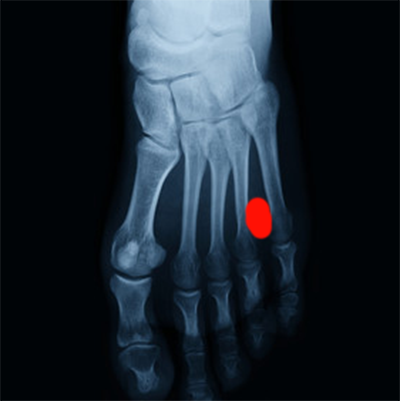This is treatment to an anatomical bursa between the 4th and 5th metatarsals (as can be seen below). (Anatomical means normally present, not an adventitious bursa, as can often be seen at the metatarsal heads, which are only present because of a problem.)
The most common cause of bursitis in this area is forced over pronation.

Extracorporeal shockwave to the foot for bursitis between metatarsals
Machine: Enraf Nonius 811
Settings: 90mj 2000 shocks at 12hz using a 15mm head
Medium: Ultrasound gel
Patient: Pain for last six months after practising for strongman competition. Pain started during yoke walk with 400kg. Previously tried massage and laser therapy with no effect. Orthotics not effective. 2nd session pain already reduced, in fact was pain free for 4 days after first treatment. Bursa is significantly swollen, even visible. Patient has pain just walking.
Effectivness:
There are many research studies on shockwave (SWT) and it’s use in bursitis. Furia et al. (2009) compared outcomes of two groups of patients with chronic bursitis. The patients undergoing shockwave improved significantly more than those in the control group. Rompe et al. (2009) compared exercise to corticosteroid injection and shockwave. One month follow up showed, corticosteroid success rate 75%; exercise 7%; shockwave 13%. At 4 months, radial SWT led to significantly better results (68%) exercise (41%) and corticosteroid injection (51%). Fifteen months follow up radial SWT (74%) and exercise (80%) were significantly more successful than was corticosteroid injection (48%). In their excellent review article Del Buono et al (2012) said repetitive low-energy radial SWT provides a beneficial effect over months, with a success rate of 68% at 4 months and 74% at 15 months. Rompe et al. (2009) evaluated the effects of SWT on patients with bursitis which had already been treated conservatively but had been unresponsive. The mean results for the shockwave group were statistically improved at 1, 3 and 12 months after treatment compared with the control group. At the 12 months assessment, the shockwave patients had significantly higher excellent and good results compared with the control group patients (79% vs. 36%). No patient reported complications and no patient required additional treatment.